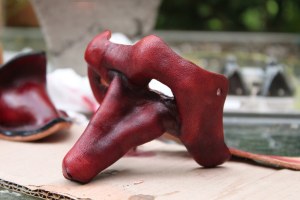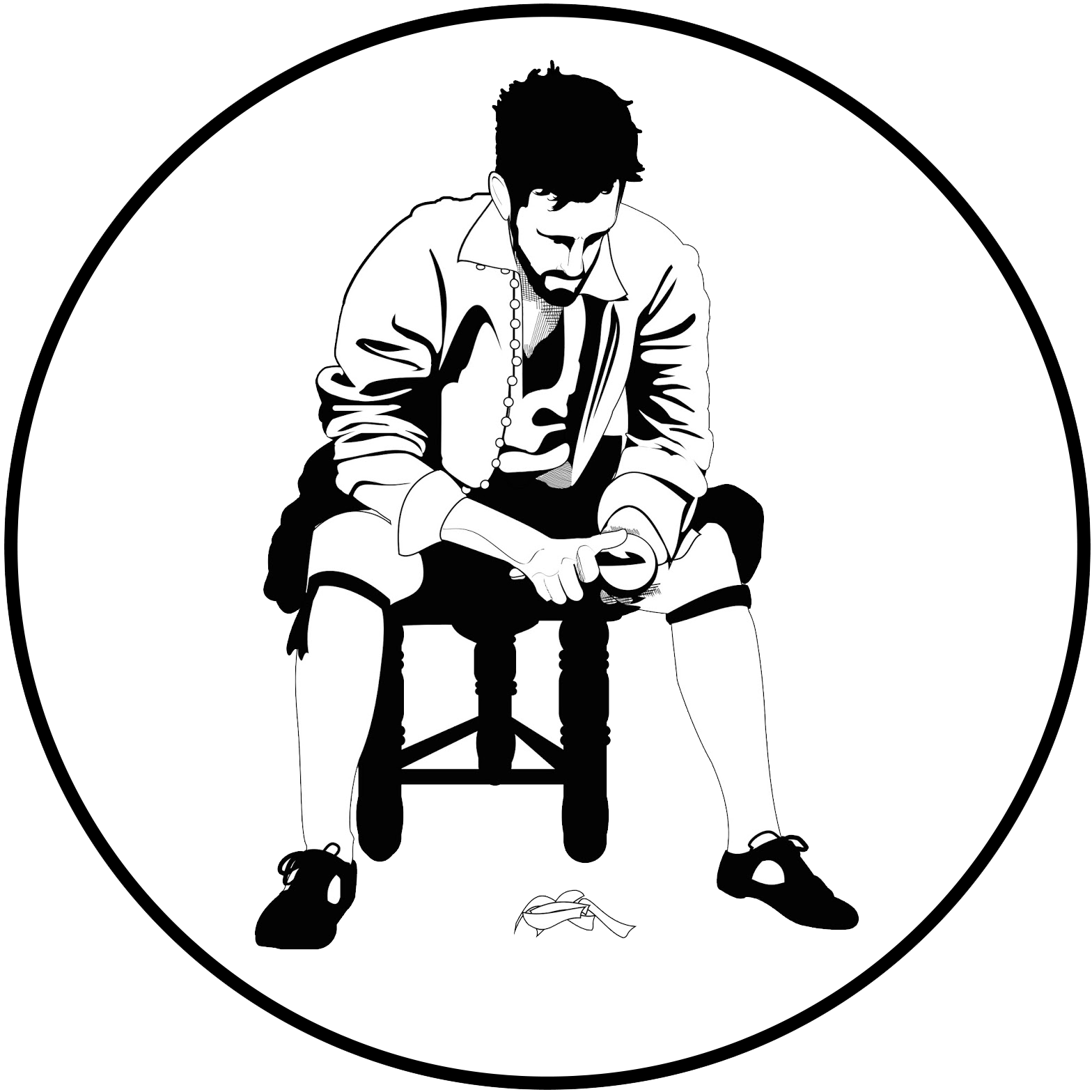Don’t call them ‘Cobblers’. A cordwainer is a shoemaker, a cobbler was actually forbidden by statute from working with new leather. His purview was restricted to repairing a cordwainer’s work after it failed. The Worshipful Company of Cordwainers controlled all aspects of the manufacture of new shoes.
Whence came the name? For that, we go straight to the horse’s mouth, as usual…
“Those who worked with the finest leather were called Cordwainers because their material came from Cordoba in Spain. They developed a soft, durable goatskin leather known as Cordwain – the very finest leather available – importation of which contributed to the growing prosperity of London. Over a period of time, those who processed the leather formed their own guilds. The shoemakers, however, retained the name of ‘Cordwainer’.” – From their site: http://www.cordwainers.org
 Much like shoe making, masks are made with the leather worked wet and formed over a carved wooden matrix. (If you are interested in maskmaking, click here for a full tutorial I wrote last year). So the first step in making either mask or shoes isn’t leather, it is carving wood.
Much like shoe making, masks are made with the leather worked wet and formed over a carved wooden matrix. (If you are interested in maskmaking, click here for a full tutorial I wrote last year). So the first step in making either mask or shoes isn’t leather, it is carving wood.
And carving wood is something I understand completely.
First things first, I had a chat via email with Francis Classe, historical cordwainer extraordinaire and all around nice guy. He’s been very helpful and supportive all along, providing not only advice, but photos and links to things he’d written as well as books of historical shoe making. Francis works with modern wooden lasts that he modifies for a period shape.
I like woodworking and I have some carving tools that haven’t been taken for a spin in far too long, so we’re going to make our own. (This is not to be confused with the fact that I have a size twelve foot and couldn’t easily find a modern last to modify. Nope! Not at all.)
Seriously though, I shake my fist as these hobbit feet on a regular basis.
Seriously, I had to get out the big sketchbook to even trace around them. I know people with larger feet than mine and I tell you now I don’t want to make shoes for any of them.
The lastmakers weren’t a proper guild in their own right, so I’ll be going through this pretty fast and hopefully we’ll get it in one. Essentially I’ll be using a lifetime of carving experience to sculpt something approximating my foot. Then I’ll do it again with the other foot.
Deviation(s) from Period Techniques: Near as I can tell, the standard practice for last makers in the period is much the same as now. Hardwoods (preferably beech) are cut to a rough shape using something called a ‘stock knife’ which aren’t easily obtained in the United States. A stock knife is a large blade with a handle on one end and a hook on the other. I’ll append a video at the bottom of this post of an experienced clogmaker using one.
The hook is secured to an eyebolt in the table as a fulcrum to form a 2nd class lever. I couldn’t find one and don’t have the werewithal to make one, also I’ll be using scraps of pine since this doesn’t have to survive the ages, just the one project. If I like doing this and want to do it again, I’ll make another out of a hardwood. In the meantime: pine.
Because my feet are deep and wide, I glued up a some chunks of 2 x 6 I had lying around and transferred my traced outline of my foot to the wood, trying to avoid knots and grain funkiness. Or at least use the grain funkiness to my advantage.
Working in all three dimensions means more cuts and switching through a series of chisels and working top and bottom. According to Francis, unlike modern lasts, period lasts tended to be flat-bottomed since heels hadn’t really become a Thing yet.
At this point, it’s time to switch to a gouge because it’s easier to create and follow curves with a gouge than it is with a bench chisel…
Most of the waste is removed, time to get to the final shaping.














Excellent! I've never carved lasts on my own, but I can imagine that it would be a rather rewarding experience. A couple of things – first, take a look at http://wherearetheelves.net/late-16thc-last-start/. Al has done basically the same thing as you, starting with a pair of 1593 lasts as a model. Notice how the lasts have a curve inwards all around the bottom of the last rather than forming a right angle – this is something that I am starting to do on my modern lasts. It results in a shoe which has a sole which is slightly smaller than the rest of the shoe, consistent with finds and with paintings/illustrations. Secondly, if you examine these lasts, notice how the slope of the front of the last as it rises towards the ankle is actually rather small. I suspect that there may have been an extra leather piece added to the front of the shoe to make up the difference. The reason you need that leather piece is because if you don't have it, it will be very difficult to get the last out of the shoe when the shoe is finished. Modern lasts have a “V” cut where you can “break” them, and slip the last out. But, with a one piece last, you need a shover (the extra leather piece) which you tie on, last the shoe, and then untie to slip the last out without significantly deforming the shoe. This is sometimes used in conjunction with a wedge to get the girth measurement correct. Check out “shover” under http://www.personal.utulsa.edu/~marc-carlson/shoe/RESEARCH/GLOSSARY/bdefs.htm. Keep up the good work!
LikeLike
Hi Francis! Thank you for those links! I see I have more stock removal ahead of me. I was wondering at how blocky it was and once I have two of them (since I'm making 'crooked' lasts, I believe you called them last time we talked)
LikeLike